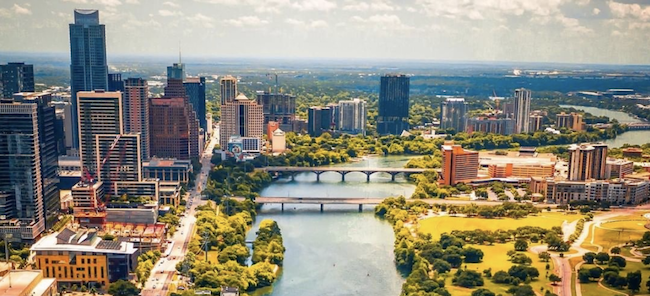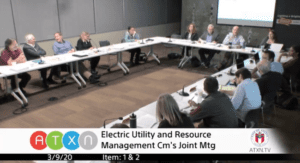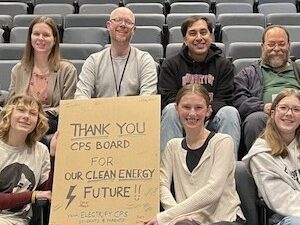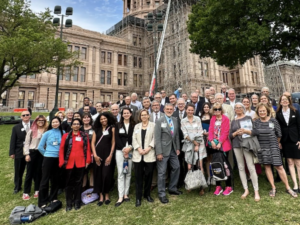
Austin, Texas. Photo by Sayaka Kunze, courtesy of Visit Austin.
Austin, Texas, puts a price on carbon
By Flannery Winchester
Like many cities, Austin, Texas, has a range of energy options available to its citizens: coal, natural gas, wind, solar, and so on. Until recently, the economics of Austin’s energy mix meant that the city was running its coal plant regularly, even when cleaner options were available. Why? Because the economics didn’t take into account all the considerations, such as the fact that burning coal produces more carbon emissions and air pollution than other energy options. Without accounting for that, it was easy for the city to continue business as usual, running the coal plant frequently.
CCL volunteer Matt Weldon understood that this was a flaw in the way we’ve designed our economic market. “On occasion, some carbon emissions can be avoided in our market for almost free—yet we weren’t assigning even a penny of value to taking that action,” Matt explains. He knew that a small price on carbon at the city level would fix that flaw.
Through some connections with his city councilman and his local Electric Utility Commission (EUC), Matt was in a good position to advocate for climate-smart policies at the city level. EUC oversees Austin Energy, the local municipal utility. “As part of an EUC committee, we had drafted a non-binding resolution on carbon pricing,” Matt says. He also gave some presentations on the idea to a relevant working group and to advocacy groups in town, building awareness and support for this approach.
Austin Energy has been doing its part in recent years, too. “Austin Energy has pursued the cheapest energy sources possible and put out bids for renewable energy every year, making Austin the leader in renewable energy of Texas cities,” said Bob Hendricks, another local CCL volunteer. They’re even moving toward closing the local coal plant, Fayette Power Project, by the end of 2022. This year, it seemed to Bob that “Austin Energy really wanted to cut carbon emissions as much as possible while still achieving strong affordability goals and were ready to pick up on Matt’s excellent idea.” This was due in no small part to pressure from CCL members and other climate activists.

On March 9, 2020, the EUC and RMC held a joint meeting to discuss the plan containing REACH, and to forward it on to the Austin City Council. CCL volunteer Matt Weldon is third from the left.
This spring, Austin Energy introduced their Resource, Generation and Climate Protection Plan of 2020. The plan states that “86% of Austin Energy’s electricity generation will be carbon-free by year-end 2025, 93% will be carbon-free by year-end 2030, and all generation resources will be carbon-free by 2035.”
How will they hit those targets? An element of this plan called “REACH,” which stands for “Reduce Emissions Affordably for Climate Health,” will help them get there. Austin Energy will use a “market-based approach” to “incorporate a cost of carbon in the generation dispatch price.”
In practice, that means the price of coal has gone from roughly $0.02/kWh to something like $0.026/kWh. (The exact numbers depend on a variety of specific caveats, Matt points out: offer price, cleared price, substitute power cost, wholesale vs. retail, and more.) This small adjustment in the pricing means that now, there’s slight economic pressure to choose cleaner energy sources. What’s cleaner is now also what’s cheaper. The coal plant will only come online during times of high demand, but mostly, the cleaner options will be pulling the load.
This small shift will, on its own, reduce the city of Austin’s carbon emissions by 30%, or approximately 4 million metric tons between now and the time the coal plant is fully closed in 2022. The plan states, “Thereafter, the REACH plan is expected to reduce carbon emissions by 8% each year, until achieving zero carbon emissions by 2035.” The city will maintain that rate of decarbonizing by placing a small carbon price on its natural gas electricity generation after the coal plant is closed.
The plan was discussed at a joint meeting of the EUC and the Resource Management Commission on March 9, 2020 (pictured above) with Matt in attendance. The plan was then approved by the Austin city council on March 26, 2020. Matt says, “CCL clearly raised the profile of carbon pricing and elevated the knowledge of our city council members and improved their comfort in moving between fiscal and environmental perspectives.”
This is a great example of how a price on carbon can work at the national level. When we account for the true costs of fossil fuels, then it becomes easy—and economically advantageous—to seek out cleaner energy options. We can see what’s cleaner in the price itself.
To date, 81 members of Congress see the benefit of this approach and have put their names on the Energy Innovation and Carbon Dividend Act, which would put a price on carbon emissions and give revenue back to Americans as a monthly dividend. Now, every member of Congress can see the idea in action as Austin’s carbon emissions steadily decline. We hope they’ll put all of America on the same path.





